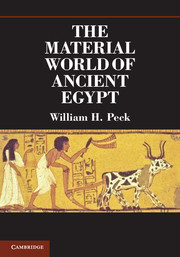Book contents
- Frontmatter
- Contents
- List of Figures
- Preface
- Acknowledgments
- Introduction
- 1 Geography and Geology
- 2 Brief Outline of Egyptian History
- 3 Study of the Material World of Ancient Egypt
- 4 Dress and Personal Adornment
- 5 Housing and Furniture
- 6 Food and Drink
- 7 Hygiene and Medicine
- 8 Containers of Clay and Stone
- 9 Tools and Weapons
- 10 Basketry, Rope, Matting
- 11 Faience and Glass
- 12 Transportation
- 13 Sport and Games
- 14 Music and Dance
- 15 Weapons and Armor
- 16 Conclusions
- Sources of Chapter Heading Quotations
- Bibliography
- Index
4 - Dress and Personal Adornment
Published online by Cambridge University Press: 05 August 2013
- Frontmatter
- Contents
- List of Figures
- Preface
- Acknowledgments
- Introduction
- 1 Geography and Geology
- 2 Brief Outline of Egyptian History
- 3 Study of the Material World of Ancient Egypt
- 4 Dress and Personal Adornment
- 5 Housing and Furniture
- 6 Food and Drink
- 7 Hygiene and Medicine
- 8 Containers of Clay and Stone
- 9 Tools and Weapons
- 10 Basketry, Rope, Matting
- 11 Faience and Glass
- 12 Transportation
- 13 Sport and Games
- 14 Music and Dance
- 15 Weapons and Armor
- 16 Conclusions
- Sources of Chapter Heading Quotations
- Bibliography
- Index
Summary
You are clothed in the robe of finest linen, the garments that clad the flesh of the god.
The Prayers of PaheriDo not covet copper, Disdain beautiful linen;
What good is one dressed in finery, If he cheats before the god?
The Instruction of Amenemope
Dress
Ideas of what constitutes dress or costume are as old and as varied as civilized humankind. The original impulse to don some sort of clothing can be explained in three ways: as the desire for protection of the body, to satisfy a developing sense of modesty, or as a need to display various kinds of social distinctions. Aspects of protection that might have determined the type of garments chosen include the need to combat the effects of climate, of heat and cold. The need for protection also includes the safeguarding of sensitive parts of the body, particularly the genital area. By contrast to the considerations of protection, a sense of modesty is a learned habit that demands concealment of various body parts, depending on the requirements or the traditions of the particular culture. In addition to the elements of protection and modesty, special types of costume and dress can provide the visual clues that differentiate social class and rank. The special costumes that are appropriate to different social positions and levels of authority utilize distinctive patterns and kinds of clothing for the male and female, and still other variations suitable for the young and old. Costume among the ancient Egyptians fulfilled these various requirements of protection, modesty, and social distinction in a variety of ways that can be studied in the sources preserved for us.
- Type
- Chapter
- Information
- The Material World of Ancient Egypt , pp. 48 - 73Publisher: Cambridge University PressPrint publication year: 2013

